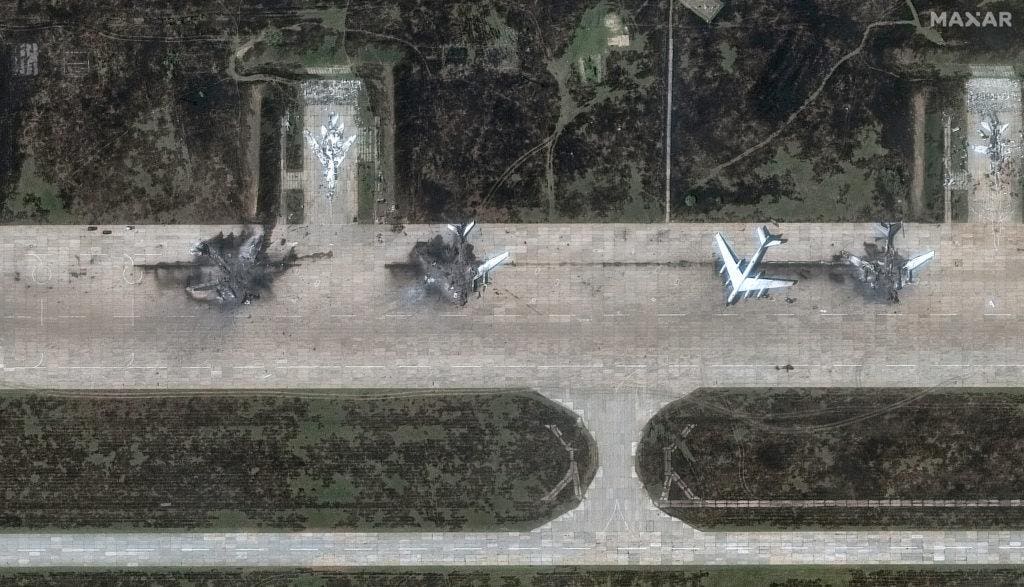Satellite imagery reveals the aftermath of a Ukrainian strike on a Russian airbase, with multiple … More
MAXAR | PBS News
Nearly every war between major powers reveals enduring lessons for future strategists. World War II taught us that airpower had become the new high ground—and that the nuclear bomb was decisive. Vietnam taught us, painfully, that the will of the people matters at least as much as firepower. Unfortunately, we had to relearn that lesson in the conflicts that followed 9/11.
Today, the Russia-Ukraine war is teaching us a critical lesson of the digital age, one we’re still not discussing enough: the major operational and strategic impact that can be made leveraging highly proliferated and networked, commercially available technology. In Ukraine, low-cost, high-impact drones are enabling Ukraine not only to defend itself but to strike deep into Russian territory (and Russia into Ukraine) in ways that would have been unimaginable just a few years ago.
The true force multiplier isn’t just the drones themselves — it’s the network effect. Drones, sensors, and software working in concert enable real-time targeting, intelligence gathering, and high-volume precision strike capability. These tools, put to use by a fierce yet an only recently constituted military, are outmatching even an adversary like Russia, whose traditional and formidable warfighting doctrine has relied upon mass and attrition. The obvious implications are so profound we must reimagine the application of key principles of war, or risk ceding the next critical domain: space, before the fight even begins.
Three of the classic principles of war must be fundamentally rethought for space, the newest warfighting domain, and the Russia-Ukraine conflict provides a preview of how:
- Mass is no longer measured or projected solely by the size or complexity of individual platforms; offensive and defensive power can now be delivered through hundreds or thousands of small, smart platforms often even more effectively. Military planners must ensure a ready supply, and commercial suppliers offer the only viable path to scale.
- Maneuver is increasingly defined and directed by software and enabled by connected networks that have become the primary attack surfaces. Protecting these networks and the data they contain must be now treated as mission-critical.
- Surprise no longer requires an expensive super-secret stealth bomber, it can just as easily come from the rapid, creative use of proliferated commercial technology employed in ways the enemy won’t anticipate.
What does this mean for space?
- Proliferation in air, sea, and especially space is the new strategic imperative. An abundance of useful assets is far more powerful than a small number of exquisite ones.
- Innovation in warfighting effectiveness happens as much in the battlefield with operators, as it did in think tanks, research labs, or test facilities just five years ago.
- Networks and software now define effectiveness as much as, if not more than, the proliferated hardware. Protecting the connected systems through zero-trust architectures and secure-by-design mandates should be a baseline requirement for every defense supplier, whether their technology is funded by government or private capital.
In the space domain, our ability to scale is now existential. Winning won’t depend on how exquisite each satellite is, but on how many we have in orbit and how intelligently they operate as an integrated whole. The Space Force needs far more funding and far more U.S. commercial companies building and delivering its advanced technology at scale. Proliferation on orbit is no longer just a low cost way to deliver an extra measure of resilience. When properly networked, it becomes a new form of strategic deterrence. The side with the most agile, connected, and numerous platforms will dominate.
Unfortunately, the United States military missed the ability to leverage the commercial drone revolution before it left for China — a nascent industry we invented and all but abandoned years ago. Today’s U.S. Air Force, with all of its impressive bunker busting power, could not have pulled off the kind of victories Ukraine has achieved against Russia. Because of our abandonment, we now face the difficult task of rebuilding critical drone manufacturing for national security, a task far more difficult to accomplish than the rapid offshoring to China we enabled that helped to create the problem.
But there is reason for optimism. Quietly, the Pentagon’s Space Development Agency has been doing the hard work of reversing this trend. In just six years, it has certified nine new U.S. small satellite manufacturers — with more on the way — that are already competing, building and deploying for the Space Force. We must build on that momentum and not slow down as the GAO is calling for. We must broaden and scale these efforts even further, and ensure that American technology populates all useful orbits, from low Earth to cislunar space.
The Russia-Ukraine conflict has made clear that success in modern war depends on resilience, speed, and the creative use of proliferated, connected technology. If we take those lessons to heart, we will secure the new high ground for generations to come.

